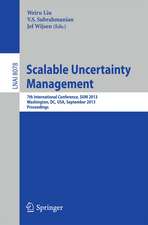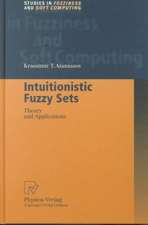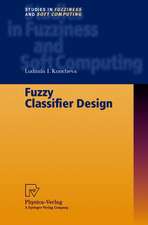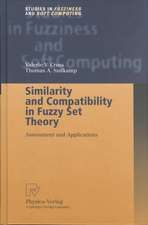Propositional, Probabilistic and Evidential Reasoning: Integrating Numerical and Symbolic Approaches: Studies in Fuzziness and Soft Computing, cartea 77
Autor Weiru Liuen Limba Engleză Hardback – 7 sep 2001
| Toate formatele și edițiile | Preț | Express |
|---|---|---|
| Paperback (1) | 645.14 lei 43-57 zile | |
| Physica-Verlag HD – 21 oct 2010 | 645.14 lei 43-57 zile | |
| Hardback (1) | 651.57 lei 43-57 zile | |
| Physica-Verlag HD – 7 sep 2001 | 651.57 lei 43-57 zile |
Din seria Studies in Fuzziness and Soft Computing
- 20%
 Preț: 999.85 lei
Preț: 999.85 lei - 20%
 Preț: 653.06 lei
Preț: 653.06 lei - 20%
 Preț: 872.96 lei
Preț: 872.96 lei - 20%
 Preț: 930.57 lei
Preț: 930.57 lei - 20%
 Preț: 1051.00 lei
Preț: 1051.00 lei - 20%
 Preț: 992.44 lei
Preț: 992.44 lei - 20%
 Preț: 655.85 lei
Preț: 655.85 lei - 20%
 Preț: 1001.86 lei
Preț: 1001.86 lei - 18%
 Preț: 954.14 lei
Preț: 954.14 lei - 20%
 Preț: 330.10 lei
Preț: 330.10 lei - 20%
 Preț: 333.04 lei
Preț: 333.04 lei - 20%
 Preț: 997.56 lei
Preț: 997.56 lei -
 Preț: 391.61 lei
Preț: 391.61 lei - 20%
 Preț: 647.79 lei
Preț: 647.79 lei - 20%
 Preț: 986.01 lei
Preț: 986.01 lei - 18%
 Preț: 958.56 lei
Preț: 958.56 lei - 20%
 Preț: 996.40 lei
Preț: 996.40 lei - 20%
 Preț: 999.35 lei
Preț: 999.35 lei - 15%
 Preț: 646.43 lei
Preț: 646.43 lei - 20%
 Preț: 651.57 lei
Preț: 651.57 lei - 20%
 Preț: 997.89 lei
Preț: 997.89 lei - 15%
 Preț: 641.03 lei
Preț: 641.03 lei - 20%
 Preț: 1009.74 lei
Preț: 1009.74 lei - 20%
 Preț: 992.62 lei
Preț: 992.62 lei -
 Preț: 388.72 lei
Preț: 388.72 lei - 18%
 Preț: 1223.43 lei
Preț: 1223.43 lei - 20%
 Preț: 651.42 lei
Preț: 651.42 lei - 18%
 Preț: 951.59 lei
Preț: 951.59 lei - 18%
 Preț: 948.61 lei
Preț: 948.61 lei
Preț: 651.57 lei
Preț vechi: 814.45 lei
-20% Nou
Puncte Express: 977
Preț estimativ în valută:
124.68€ • 130.50$ • 103.77£
124.68€ • 130.50$ • 103.77£
Carte tipărită la comandă
Livrare economică 31 martie-14 aprilie
Preluare comenzi: 021 569.72.76
Specificații
ISBN-13: 9783790814149
ISBN-10: 3790814148
Pagini: 288
Ilustrații: XIV, 274 p.
Dimensiuni: 155 x 235 x 21 mm
Greutate: 0.59 kg
Ediția:2001
Editura: Physica-Verlag HD
Colecția Physica
Seria Studies in Fuzziness and Soft Computing
Locul publicării:Heidelberg, Germany
ISBN-10: 3790814148
Pagini: 288
Ilustrații: XIV, 274 p.
Dimensiuni: 155 x 235 x 21 mm
Greutate: 0.59 kg
Ediția:2001
Editura: Physica-Verlag HD
Colecția Physica
Seria Studies in Fuzziness and Soft Computing
Locul publicării:Heidelberg, Germany
Public țintă
ResearchCuprins
1 Introduction.- 2 Incidence Calculus.- 3 Generalizing Incidence Calculus.- 4 From Numerical to Symbolic Assignments.- 5 Combining Multiple Pieces of Evidence.- 6 The Dempster-Shafer Theory of Evidence.- 7 A Comprehensive Comparison of Generalized Incidence Calculus and Dempster-Shafer Theory.- 8 Assumption-Based Truth Maintenance Systems.- 9 Relations Between Extended Incidence Calculus and Assumption-Based Truth Maintenance System.- 10 Conclusion.- Mathematical Notation.- List of Figures.- List of Tables.
Textul de pe ultima copertă
The book systematically provides the reader with a broad range of systems/research work to date that address the importance of combining numerical and symbolic approaches to reasoning under uncertainty in complex applications. It covers techniques on how to extend propositional logic to a probabilistic one and compares such derived probabilistic logic with closely related mechanisms, namely evidence theory, assumption based truth maintenance systems and rough sets, in terms of representing and reasoning with knowledge and evidence.
The book is addressed primarily to researchers, practitioners, students and lecturers in the field of Artificial Intelligence, particularly in the areas of reasoning under uncertainty, logic, knowledge representation and reasoning, and non-monotonic reasoning.
The book is addressed primarily to researchers, practitioners, students and lecturers in the field of Artificial Intelligence, particularly in the areas of reasoning under uncertainty, logic, knowledge representation and reasoning, and non-monotonic reasoning.
Caracteristici
The reader gains relatively complete knowledge about how a pure numerical, pure symbolic, or hybrid system behaves Systemati review of the work on integrating numerical and symbolic approaches Illustration by a large number of examples Includes supplementary material: sn.pub/extras

















